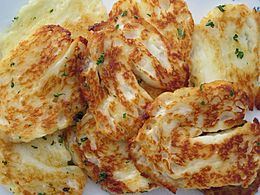Halloumi facts for kids
Halloumi is a white cheese made out of goat's milk. It is not a hard or a soft cheese, and can be fried to a crispy coating.
By country/region
Cypriot Halloumi
Halloumi cheese originated in Cyprus in the Medieval Byzantine period (AD 395 – 1191), and was subsequently eaten throughout the Middle East. Cypriot famers relied on Halloumi as a source of protein and in many villages the entire community would join forces and make huge batches together. Recipes varied from village to village, with each taking great pride in their special technique and secret ingredients. Halloumi became so important to village life that even the surnames of many Cypriot families reflect their role in Halloumi production, with names such as Hallumas, Halluma and Hallumakis common by the 19th century.
The cheese is white, with a distinctive layered texture, similar to mozzarella and has a salty flavour. It is stored in its natural juices. It must be garnished with mint, a practice based on the fact that halloumi keeps better and stays fresher and more flavoursome when wrapped with mint leaves. In accordance with this tradition, all packages of halloumi contain fragments of mint leaves on the surface of the cheese.
The cheese is often used in cooking and can be fried until brown without melting, owing to its higher-than-normal melting point. This makes it an excellent cheese for frying or grilling (like for saganaki) or fried and served with vegetables, or as an ingredient in salads. Cypriots like eating halloumi with watermelon in the warm months, and as halloumi and lountza, a combination of halloumi cheese and either a slice of smoked pork, or a soft lamb sausage.
The resistance to melting comes from the fresh curd being heated before being shaped and placed in brine. Traditional halloumi is a semicircular shape, about the size of a large wallet, weighing 220–270 g. The fat content is approximately 25% wet weight, 47% dry weight with about 17% protein. Its firm texture when cooked causes it to squeak on the teeth when being chewed.
Traditional halloumi is made from unpasteurised sheep and goat milk. Many people also like halloumi that has been aged; kept in its brine, it is much drier, much stronger and much saltier, making it very different from the milder halloumi generally used in the West.
Halloumi is registered as a protected Cypriot product within the United States (since the 1990s) but not yet in the European Union. The delay in registering the name halloumi with the EU has been largely due to a conflict between dairy producers and sheep and goat farmers as to whether registered halloumi may contain cow’s milk, and how much. Most Cypriots agree that, traditionally, halloumi was made from sheep and goat milk, since there were few cows on the island until they were brought over by the British in the 20th century. But as demand grew, industrial cheese-makers began using more of the cheaper and more-plentiful cow's milk.
Middle East
Halloumi is regularly consumed in many parts of the Levant such as Lebanon, Turkey, Syria, Palestine, Jordan, Israel, Egypt and Iraq. It is a traditional component of the Levantine breakfast, eaten either fresh or fried, along with other dishes such as hummus, falafel, and khubz. Halloumi cheese is very similar to Nablusi cheese, named after Nablus, Palestine, its city of origin. Some believe that Halloumi cheese is of Levantine creation, due to its similarity to Nablusi cheese and the region's long history of consuming Halloumi cheese. Halloumi in Israel is sometimes fried in olive oil and served for breakfast and served with meze. It is also eaten with fish.
Images for kids
See also
 In Spanish: Halloumi para niños
In Spanish: Halloumi para niños




